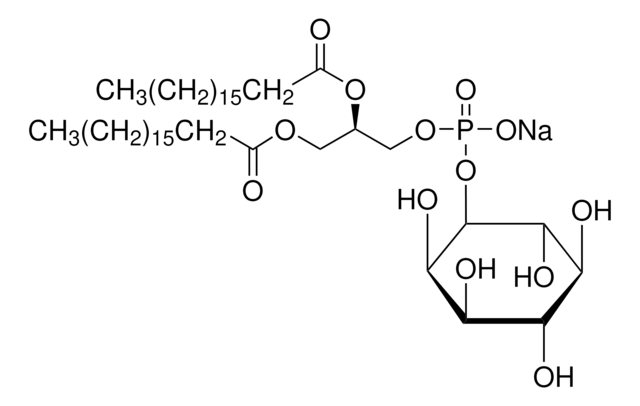850151P
Avanti
18:1 PI(4)P
Avanti Research™ - A Croda Brand 850151P, powder
Sinónimos:
1,2-dioleoyl-sn-glycero-3-phospho-(1′-myo-inositol-4′-phosphate) (ammonium salt)
About This Item
Productos recomendados
assay
>99% (TLC)
form
powder
packaging
pkg of 1 × 100 μg (with stopper and crimp cap (850151P-100ug))
pkg of 1 × 500 μg (with stopper and crimp cap (850151P-500ug))
manufacturer/tradename
Avanti Research™ - A Croda Brand 850151P
lipid type
cardiolipins
phospholipids
shipped in
dry ice
storage temp.
−20°C
SMILES string
[H][C@@](COP([O-])(O[C@H]1[C@H](O)[C@@H](O)[C@H](OP([O-])(O)=O)[C@@H](O)[C@H]1O)=O)(OC(CCCCCCC/C=C\CCCCCCCC)=O)COC(CCCCCCC/C=C\CCCCCCCC)=O.[NH4+].[NH4+]
InChI
1S/C45H84O16P2.2H3N/c1-3-5-7-9-11-13-15-17-19-21-23-25-27-29-31-33-38(46)57-35-37(59-39(47)34-32-30-28-26-24-22-20-18-16-14-12-10-8-6-4-2)36-58-63(55,56)61-45-42(50)40(48)44(41(49)43(45)51)60-62(52,53)54;;/h17-20,37,40-45,48-51H,3-16,21-36H2,1-2H3,(H,55,5
InChI key
XDKQBHORSIMQSB-QVUMANCCSA-N
General description
Application
Biochem/physiol Actions
Packaging
Legal Information
also commonly purchased with this product
Storage Class
11 - Combustible Solids
wgk_germany
WGK 3
flash_point_f
No data available
flash_point_c
No data available
Elija entre una de las versiones más recientes:
Certificados de análisis (COA)
It looks like we've run into a problem, but you can still download Certificates of Analysis from our Documentos section.
Si necesita más asistencia, póngase en contacto con Atención al cliente
¿Ya tiene este producto?
Encuentre la documentación para los productos que ha comprado recientemente en la Biblioteca de documentos.
Global Trade Item Number
| Número de referencia del producto (SKU) | GTIN |
|---|---|
| 850151P-100UG | 4061835229550 |
| 850151P-500UG | 4061835229567 |
Nuestro equipo de científicos tiene experiencia en todas las áreas de investigación: Ciencias de la vida, Ciencia de los materiales, Síntesis química, Cromatografía, Analítica y muchas otras.
Póngase en contacto con el Servicio técnico
